

The Unintended Consequences of Taxing Unrealized Gains
In case you missed it, a $5 trillion tax hike looms over American households and businesses in President Joe Biden’s latest budget proposal, which would include a 25% annual minimum tax on unrealized capital gains for individuals with incomes and assets exceeding $100 million.
If signed into law, this would increase the top marginal rate on long-term gains and dividends to a jaw-dropping 44.6%, marking the highest such rate in U.S. history.
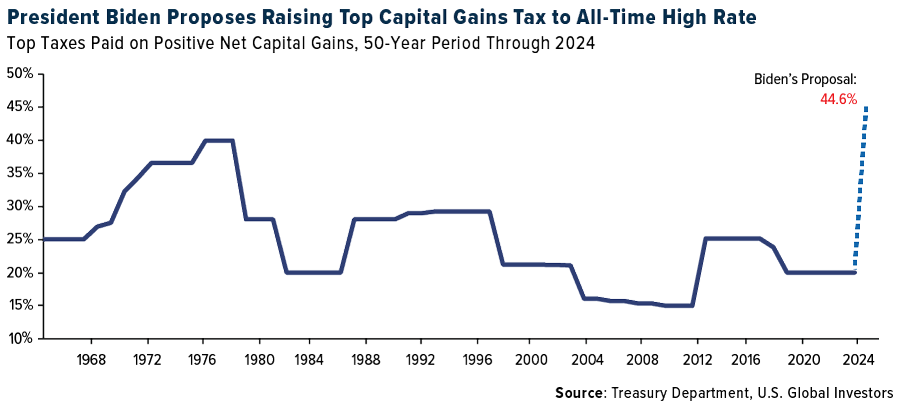
Biden’s plan proposes other changes to the tax code, but I want to focus on the part involving unrealized gains since it could have sweeping unintended consequences for the U.S. economy, personal liberty and the very fabric of American innovation.
To be clear, I don’t believe a deeply divided Congress would be able to find the votes necessary to approve this policy, but it’s crucial that people are at least aware of the potential ramifications.
When Gains Aren’t Gains
The idea of taxing unrealized capital gains—increases in the value of an asset like property or stocks that haven’t been sold yet—is not only unprecedented but fundamentally flawed.
Imagine purchasing shares in a company for $1 million, and next year, those shares appreciate to $1.5 million. Under Biden’s plan, you would owe taxes on this $500,000 gain, despite not having sold the shares or realized any actual profit.
Now imagine that the stock’s value drops back to $1 million the following year. You’ve already paid 25% on a gain that existed only on paper, and now you’re also left shouldering a financial burden without any actual economic benefit.
You can see how this policy might not go over well with the investment community. As influential entrepreneur Anthony Pompliano tweeted yesterday, “If they want to collect unrealized gains, we’re going to need refunds on unrealized losses.”
If they want to collect unrealized gains, we’re going to need refunds on unrealized losses.
— Pomp 🌪 (@APompliano) April 25, 2024
Scott Melker, host of the popular Wolf of All Streets podcast, commented that wealthy investors would simply employ a special strategy to minimize the impact of this additional tax burden. Rich people, he says, “will just take more loans against their portfolios,” knowing that the interest they pay on those loans can often be deducted.
If taxes go to 44% on cap gains, then rich people will just take more loans against their portfolios and never sell.
— The Wolf Of All Streets (@scottmelker) April 26, 2024
And the interest on those loans is… TAX DEDUCTIBLE!
Government will make less.
It’s all so tiresome.
Impact on Small Caps and Startups
This policy could dramatically distort investment behavior, especially when it comes to small caps, startups and early-stage companies. These businesses are often the engines of growth and innovation within the economy, but they rely on investments from those willing to take risks for the promise of future returns.
Knowing that their unrealized gains will be taxed, investors would be less inclined to invest in growth-oriented businesses, which tend to see greater levels of volatility year-over-year than larger, more established companies.
The consequence? A slower rate of innovation and a reduced growth in productivity.
Broad Opposition to New Tax Measures
You probably won’t be surprised to learn that Americans overwhelmingly oppose the taxation of unrealized gains. A 2021 study found that Americans reject this policy by a three-to-one margin, including a significant 76% of independent voters. This sentiment stems from a fundamental belief in economic liberty and the principle that a gain is not truly a gain until it is realized.
The resistance to such tax policies is not merely financial but deeply psychological, rooted in the American ideals of fairness and the right to enjoy the fruits of one’s labor without government interference.
How Tax Policies Drive Demographic Shifts
Higher taxes also influence shifts in demographics. As some of you may know from first-hand experience, high-tax environments drive individuals—and capital—to more hospitable fiscal climates.
Data from the Census Bureau vividly illustrates this, with significant net inbound migration to states where tax burdens are below the national average. Take a look below. New York, Illinois and California, which impose heavy tax burdens on their residents, had the largest percentages of people leaving between 2020 and 2023, while Texas, Florida and South Carolina saw their populations grow the fastest.
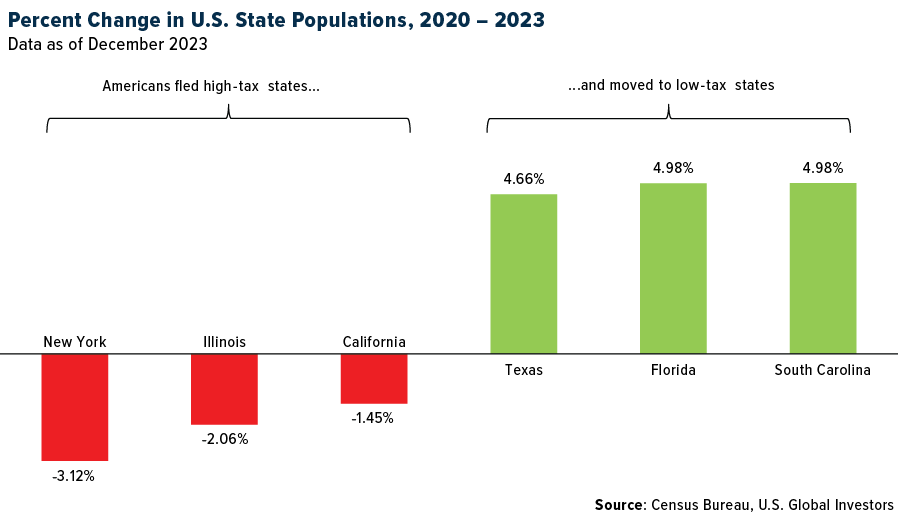
I often say that money tends to flow where it’s respected the most, and this trend underscores that sentiment well.
Small Caps Feeling the Pressure
This is set against a backdrop of rising Treasury yields as inflation concerns persist and doubts grow that the Federal Reserve will be able to lower rates this year. High borrowing costs have impacted us all, but they’ve been especially challenging to small-cap stocks, which are generally more sensitive to economic shifts due to their higher debt loads and smaller financial cushions.
The chart below illustrates the inverse relationship between the 10-year yield and the Russell 2000. When the bond yield traded above its 50-day moving average, the selloff in small-cap stocks accelerated.
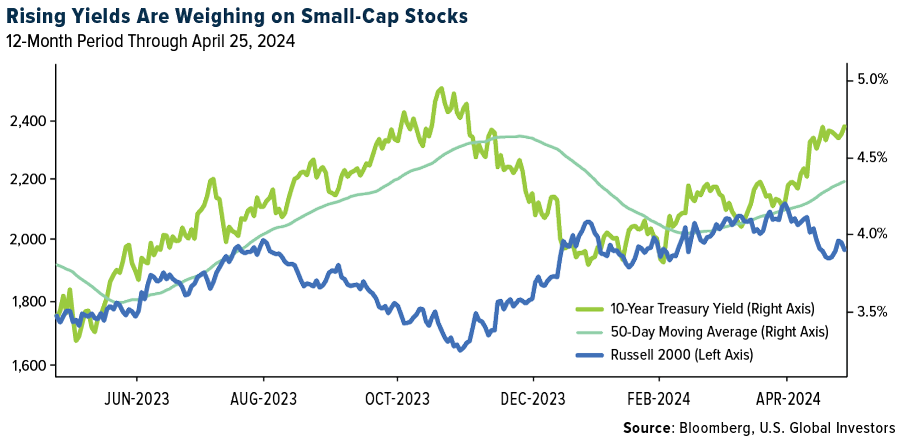
Small-cap stocks may continue to encounter significant obstacles, especially if rates remain inflated and Biden succeeds in taxing unrealized gains. Relative to the S&P 500, small caps are trading at their lowest levels since the dotcom bubble, making this a potentially interesting buying opportunity.

Index Summary
- The major market indices finished up this week. The Dow Jones Industrial Average gained 0.67%. The S&P 500 Stock Index rose 2.67%, while the Nasdaq Composite rose 4.23%. The Russell 2000 small capitalization index gained 2.79% this week.
- The Hang Seng Composite gained 15.48% this week; while Taiwan was up 3.04% and the KOSPI rose 2.49%.
- The 10-year Treasury bond yield rose 4 basis points to 4.664%.
Airlines and Shipping
Strengths
- The best performing airline stock for the week was Grupo Aeroportuario del Pacifico, up 19.0%. Passenger throughput was up 4% year-over-year on 5% year-over-year capacity growth. Airline web traffic was higher by 6% year-over-year for the week, according to ISI.
- Global air and sea freight volumes rebounded strongly in year-over-year terms in the first quarter, driven by strong Chinese exports, an inflection in the inventory cycle, and a stabilization in global manufacturing, reports Goldman. Air and ocean freight rates have strengthened and stabilized recently despite continued capacity inflows, reflecting both disruptions but also likely robust shipping demand.
- Grupo Aeroportuario del Pacifico (and the other Mexican airports) are breaking out. The positive surprise came on the back of a beat on aeronautical revenues per passenger – from higher volumes. Volaris (the No. 2 airline in Mexico) reported a strong passenger volume quarter. Airport revenue correlates closely with passenger traffic. Mexico is one of the two leading beneficiaries (along with India) from nearshoring. Mexico is the U.S.’s No. 1 trading partner now and recently achieved Class 1 airline status with America.
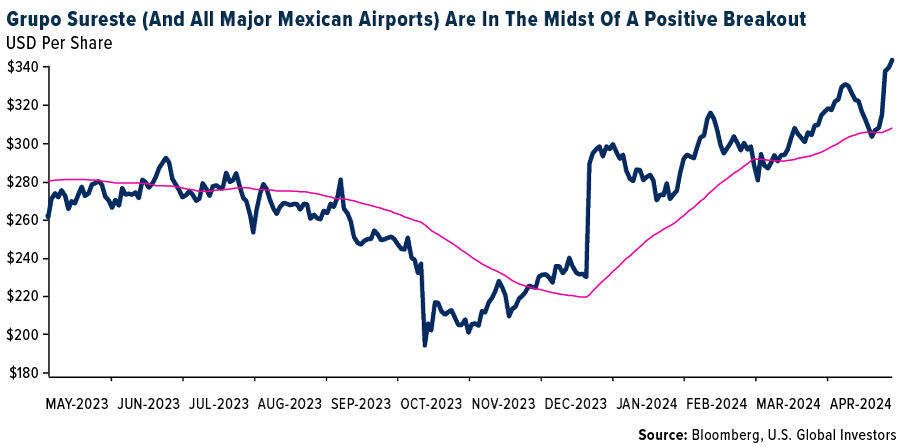
Weaknesses
- The worst performing airline stock for the week was JetBlue, down 18.9%. Boeing discussions regarding Spirit AeroSystems are progressing slowly. There are reports indicating talks hit a snag regarding Airbus assets, reports Bloomberg.
- Air freight rates showed modest sequential correction with Shanghai to Los Angeles, New York, and London down by 1%, 5% and 10% last month, respectively. Ocean freight rates saw a similar trend with Shanghai to U.S./Europe down 5-13% last month, according to JPMorgan.
- Boeing traded lower after Moody’s downgraded the company from Baa3 to Baa2 and maintained its negative outlook. Moody’s had placed Boeing debt on review for a downgrade earlier in March.
Opportunities
- Japan Airlines Co. reported preliminary March international traffic up 7.6% year-over-year with international capacity up 5% year-over-year and a load factor of 82.8%, according to FactSet. The carrier is a big beneficiary of the reopening of the Japanese economy and high inbound tourism.
- The tanker cycle continues to gain momentum as oil demand improves, ton-mile expansion is still evolving, and the orderbook, though up from 2022 lows, remains near 1990s levels. ISI has needed to account for new trade lanes resulting from Russian aggressions, which is adding to miles sailed by tankers.
- Travel + Leisure Co. and Allegiant announced a multi-year marketing agreement, allowing both companies to grow their customer engagement through cross-company promotion; the two travel companies will share promotional offerings to each other’s customers, providing offers to a broad spectrum of travelers. Allegiant, with more than 15 million “Allways Rewards” members, and Travel + Leisure Co., with more than 800,000 vacation ownership members and 3.5 million vacation exchange members, will each benefit from a highly engaged base of travelers.
Threats
- Delta Air Lines lowered domestic capacity by 400 basis points (bps) and 430bps in August and September, respectively. Current schedules show Delta’s capacity growth tracking toward 4.7%/+8.3% in August/September, below American Airlines’ domestic growth, reports Bank of America.
- The “Big Three” West Coast Ports (L.A., Long Beach, and Oakland) reported March 2024 traffic – with combined inbound loaded containers up 16% year-over-year, which is above the pre-pandemic five-year average of 3.5% year-over-year. Sequentially, the combined data was down 6% last month, which is below the five-year average, according to Goldman.
- JetBlue indicated that significant elevated capacity in its Latin American region, which represents 35% of JetBlue’s network, will likely continue to pressure revenue. The carrier expects a setback in its expectations for the full year.
Luxury Goods and International Markets
Strengths
- Louis Vuitton makes up 4% of all French exports. The luxury conglomerate, headquartered in Paris, predominantly manufactures its products in France and Italy. A recent study conducted by Asteres Consulting for LVMH revealed that the company exported goods worth $23.5 billion, surpassing the 3.2% contribution from the entire agricultural sector.
- Germany, the largest economy in Europe, has seen consumer confidence reach a two-year high, standing at -24.2. While still in negative territory, there’s a noticeable improvement. This positive shift is attributed to rising real incomes and lower inflation, which have bolstered purchasing power and stimulated consumer spending.
- RealReal, an online platform for the resale of luxury goods, was the best-performing S&P Global Luxury stock, gaining 15.7% in the past five days. Shares gained on expectations that the luxury resale maker will grow this year. According to GlobalData, the secondhand apparel market could climb to $350 billion by 2028 vs. $197 billion in 2023.
Weaknesses
- In the first quarter, Tesla disclosed revenue of $21.3 billion, marking an 8.5% decline from the previous year. Earnings per share fell short of projections at 45 cents versus an anticipated 52 cents. Car deliveries during the quarter amounted to 386,810 units, reflecting a 20% decrease compared to the corresponding period in the prior year, (despite a production increase of 47,000 vehicles). Additionally, the company experienced its largest drop in free cash flow.
- As expected, Kering reported weaker financial results due to the underperformance of Gucci in China. Gucci revenue was the weakest link, reported at EUR 2.08 billion, down 21% on a year-over-year basis. The company said the first half of operating income would decline by 40-45%.
- Faraday Future Intelligent was the worst-performing S&P Global Luxury stock, losing 20.8% in the past five days. Shares declined further after the company lost 99% of its market share last year. The threat of delisting is on the rise.
Opportunities
- The Eurozone Service PMI surpassed forecasts from numerous Bloomberg economists, coming in higher than anticipated. The preliminary EU Service PMI for April stood at 52.9, exceeding expectations of 51.8 and surpassing the previous month’s reading of 51.5. This robust performance in the service sector is likely to bolster consumer spending, particularly in luxury goods.
- In the first quarter of the year, the median price of luxury homes in the U.S. surged by 9% year-over-year, reaching a historic high of $1.225 million. Luxury home sales also saw a 2.1% increase in the first three months compared to the previous year, whereas non-luxury home sales experienced a 4.2% decline. Notably, buyers of pricier homes often opted to pay in cash, sidestepping loans with interest rates exceeding 6%.
- Hermes experienced a notable surge in first-quarter sales, primarily fueled by robust performance in its leather goods segment. However, the watch and perfume sectors exhibited slightly weaker performance. The company achieved double-digit growth across all geographic regions, with Japan seeing a remarkable 25% increase, followed by 14% growth in the rest of Asia, America, and Europe.
Threats
- On Monday, the U.S. Federal Trade Commission took action to prevent Tapestry’s proposed $8.5 billion acquisition of Capri Holdings Ltd. The merger of Capri and Tapestry would create the largest luxury brand in the United States, second only to the European powerhouse Louis Vuitton (LVMH). Shares of Capri declined 8% on the news.
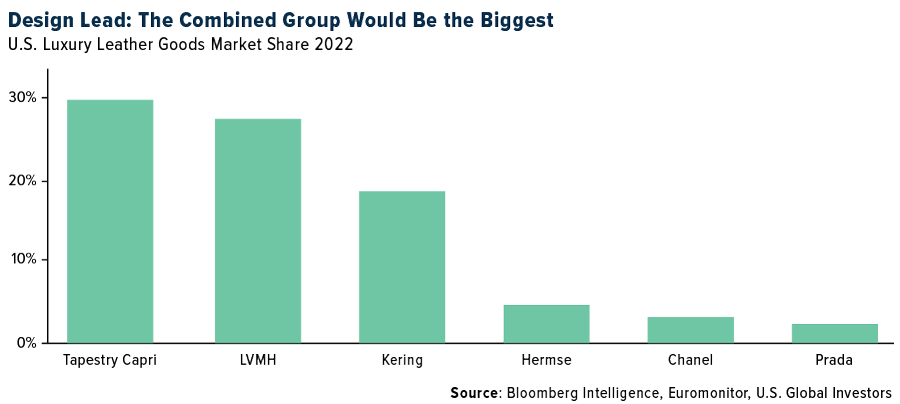
- Citi analysts have warned that Burberry is at risk of takeover, after losing a fifth of its value since the start of the year. Burberry has been one of the worst performers in the FTSE 100 Index so far this year, mostly due to the slowing demand for luxury goods in China.
- Next week, the final U.S. Global Manufacturing PMI will be released, with expectations pointing to a figure below the pivotal 50 mark, at 49.9. In contrast, at the close of March, the PMI stood above 50, at 51.9. This 50-level threshold is significant as it indicates whether manufacturing activity is in expansionary or contractionary territory.

Energy and Natural Resources
Strengths
- The best performing commodity for the week was wheat, rising 9.84%, as traders began covering shorts on emerging weather concerns in key production centers of Russia and the U.S. Bloomberg reports that dry weather in the south of Russia, and a drought across nearly the entire state of Kansas, are raising concerns over a poor harvest season. Copper rallied towards $10,000 a ton this week, hitting a new two-year high on its way, as investors continue to pile in on a bet that miners will struggle to service a surge in demand for the bellwether industrial metal, reports Bloomberg.
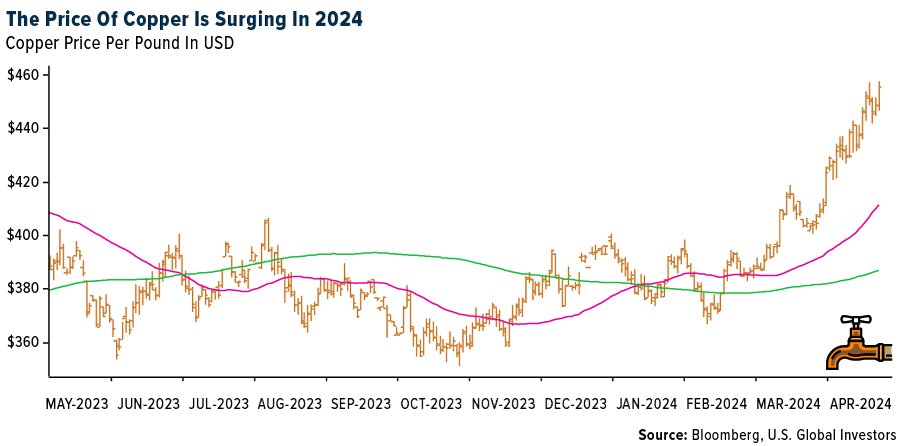
- Sungrow Power Supply Co., one of the biggest solar sector companies, reported that full-year earnings jumped 163% as its higher-margin products avoided the worst of a wider clean energy downturn, according to Bloomberg.
- ArcelorMittal Calvert is planning for an advanced manufacturing facility in Calvert, AL, that could deliver 150,000 metric tons (Mt) of domestic production capacity of non-grain-oriented electrical steel (NOES), annually. In support of this clean energy project, ArcelorMittal Calvert has been awarded $280.5 million in investment tax credits from the U.S. Internal Revenue Service as part of the Qualifying Advanced Energy Project Credit (48C) program.
Weaknesses
- The worst performing commodity for the week was natural gas, dropping 7.88%, as high domestic storage levels of natural gas are keeping a lid on any price gains. Oil fell below $81 after some of the premium from conflict in the Middle East continues to fade from markets early in the week. An uneasy calm has descended on the market after prices whipsawed on Friday, with Iran downplaying Israel’s response to the Islamic Republic’s unprecedented drone and missile strike a week earlier, reports Bloomberg. Oil closed the week with a gain of about 1.8%.
- China’s blistering roll-out of solar capacity slowed as grids struggled to build enough power lines and backup capacity, writes Bloomberg. The country installed 45.7 gigawatts of photovoltaic panels in the first three months, up more than a third from a year earlier, the National Energy Administration said in a statement on Monday.
- Global crude steel production decreased by 4.3% year-over-year in March, driven by year-overyear declines in China (-7.8%) and EU27+UK (-4.8%) and was partly offset by robust year-over-year growth in India (+7.8%) and Vietnam (+22.5%) and a post-earthquake recovery in Turkey (+18%), according to Morgan Stanley.
Opportunities
- Africa must invest $9.3 billion to expand fuel-transportation infrastructure to avoid supply disruptions as demand grows, according to Puma Energy, one of the continent’s biggest fuel retailers. Fuel distribution units of traders including Vitol Group see Africa as a place of transportation growth that is reliant on gasoline and diesel — which will require investment, according to Bloomberg.
- Tin exports from Indonesia posted their weakest quarter since at least 2007, reports Bloomberg, even after rising in March. The three-month showing is a sign of how licensing snarls in the major global producer are tightening the metal’s already stressed supply chain at a time when a squeeze may be building.
- Total Energies has signed an agreement with Sapura Upstream Assets to acquire its 50% interest in Malaysian independent gas producer and operator Sapura OMV Upstream for a consideration of $530 million, subject to closing adjustments. Closing is expected in the second half, according to FactSet.
Threats
- The physical Newcastle-U.S. coal spread significantly narrowed following the Baltimore port disruption, from 21 USD per ton in mid-March to a four-month low of -3 USD per ton at the end of March. They continue to believe that the coal price support from supply disruptions will be temporary and limited, and Goldman maintains its coal forecasts of $117 per ton for the second quarter.
- Copper’s powerful rally close to $10,000 a ton is facing a test as buyers in China, the world’s biggest market, balk at prices near their highest in two years. But skeptics have pointed to weakness in China — including what they say is a growing reluctance among the country’s copper fabricators to accept higher levels, according to Bloomberg.
- Headwinds are present to Codelco’s copper production. Chile’s copper production has been under pressure, also because of operational issues at Codelco, which is running 300-400Kt below its long-term target, according to Bank of America.
Bitcoin and Digital Assets
Strengths
- Of the cryptocurrencies tracked by CoinMarketCap, the best performer for the week was Bonk, rising 77%.
- Morgan Stanely is looking to allow its 15,000 brokers to recommend Bitcoin ETFs to their customers. The firm opened up Bitcoin ETF purchases after they had been approved earlier this year, reports Bloomberg, and the bank is now looking to let its brokers pitch them directly to customers.
- Pantera Capital, one of the largest managers of digital assets, is seeking to raise more than $1 billion for a new fund that would offer investors exposure across the spectrum of blockchain assets, writes Bloomberg.
Weaknesses
- Of the cryptocurrencies tracked by CoinMarketCap, the worst performer for the week was Toncoin, down 17%.
- Tether will freeze wallets evading Venezuelan sanctions. The firm froze 41 wallets tied to the U.S. Treasury Department’s office of foreign asset control, writes Bloomberg.
- Cboe Global Markets, the first mainstream exchange to let people buy and sell Bitcoin futures, is closing down its spot digital asset trading platform and folding its crypto operations into existing derivatives and clearing business lines. The changes are being made as part of a strategic review, taking into consideration the lack of regulatory clarity in the digital asset market, writes Bloomberg.
Opportunities
- Digital payments company Block Inc., formerly known as Square, has finished the development of its Bitcoin mining chip as the CEO continues to advocate for a more accessible and decentralized system. The chip has been a bottleneck for any newcomers to compete with the incumbent, writes Bloomberg, as the development process can be time consuming.
- Hong Kong is set to follow in the footsteps of the U.S. by listing a batch of cryptocurrency ETFs, writes Bloomberg, providing a window on whether the city is making progress on fashioning a hub for digital assets. Some of China’s top asset managers are in the final leg of preparations for the spot Bitcoin and Ether ETFs to begin trading potentially by the end of April.
- Stripe is bringing back crypto payments by allowing merchants using its platform to accept stablecoins for online transactions. The company’s co-founder says that stablecoins are becoming “more stable” while demonstrating a crypto payment on Stripe using Circle’s USDC token during a recent presentation, writes Bloomberg.
Threats
- The SEC wants to impose a $5.3 billion fine on Terraform Labs and its co-founder Do Kwon, the inventor of the failed TerraUSD stablecoin. Details of the proposed fine, which would be the crypto industry’s largest, come after Kwon and Terraform were found liable earlier in April following a two-week trial in New York, writes Bloomberg.
- Open interest at Chicago-based CME Bitcoin futures market is down 18% from a record high, a sign of wavering interest in crypto-related exposure and hedging among U.S. institutions, writes Bloomberg.
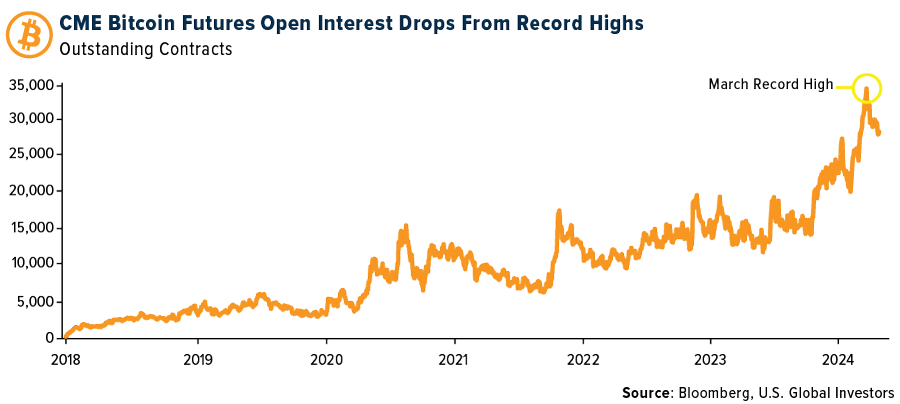
- Investors pulled a net $218 million from U.S. Bitcoin exchange traded funds, one of their worst daily outflows as demand for risky investments take a knock from fading hopes for the Federal Reserve interest rate cuts, Bloomberg reports.

Defense and Cybersecurity
Strengths
- U.S. President Joe Biden signed a $95 billion aid package for Ukraine, Israel, and Taiwan into law, a move that not only reaffirms bipartisan support for these nations but also promises substantial profits for U.S. military companies.
- Northrop Grumman’s first-quarter sales reached $10.13 billion, surpassing estimates. The company maintained its full-year earnings forecast with an earnings per share (EPS) guidance of $24.45 to $24.85, benefiting from strong government spending and reporting a substantial $78.92 billion backlog.
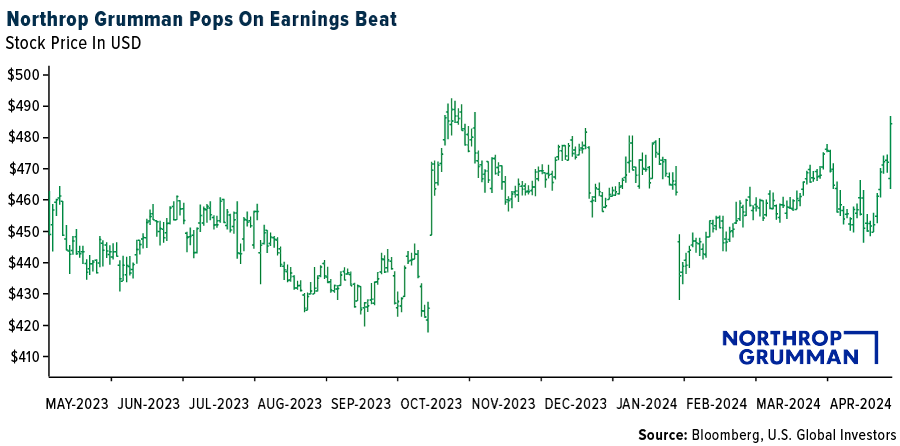
- The best performing stock in the XAR ETF this week was Archer Aviation, rising 10.14%. The company signed a comprehensive multi-million-dollar agreement with Abu Dhabi to accelerate the launch of commercial air taxi operations in the UAE, incorporating local manufacturing and training initiatives, and establishing Abu Dhabi as a global hub for urban air mobility.
Weaknesses
- Russia is recruiting up to 30,000 contract soldiers monthly to bolster its invasion of Ukraine without resorting to a mass draft that could decrease public support. Russia is focusing instead on replacing losses and increasing troop strength to maintain military pressure despite potential strategic limits.
- Despite escalating sanctions, Russia’s Economy Ministry has upgraded its 2024 GDP growth forecast from 2.3% to 2.8%, buoyed by robust domestic demand and increased government spending in the defense sector.
- The worst performing stock in the XAR ETF this week was Textron, losing 7.28%. The company reported lower-than-expected first-quarter profits and revenues across all major units.
Opportunities
- Anduril Industries and General Atomics Aeronautical Systems are set to progress in the Air Force’s $6.4 billion program to develop advanced drones as wingmen for manned jets, with plans for a production decision by 2026 and full operational deployment by 2029.
- NASA is preparing to launch its Advanced Composite Solar Sail System using a Rocket Lab Electron rocket from New Zealand. The goal is to test solar sail propulsion by deploying a CubeSat 600 miles above Earth. This technology, developed to potentially enable more economical missions to the moon and Mars, will be demonstrated through maneuvers that adjust the satellite’s altitude using only the pressure of sunlight.
- U.K. Prime Minister Rishi Sunak announced a significant ramp-up in defense spending to 2.5% of GDP by the decade’s end and pledged £500 million in military aid to Ukraine. These steps are crucial to bolster national and allied defense in a risky global climate and align with NATO’s spending goals amidst ongoing conflicts.
Threats
- Lockheed Martin’s Sikorsky division is set to lay off employees following the U.S. Army’s cancellation of the Future Attack Reconnaissance Aircraft program. This impacts less than 1% of the workforce, potentially affecting up to 400 jobs, according to NBC Connecticut.
- The Israeli military escalated its operations against Hezbollah by striking around 40 targets in southern Lebanon, following intensified skirmishes that included Hezbollah’s deep incursion into Israel since the Gaza conflict began.
- Following the U.S. approval of a $61 billion military aid package for Ukraine, Russia’s Defense Minister Sergei Shoigu announced plans to intensify attacks on Western weapons storage sites in Ukraine. The plans target newly established logistics centers and arms maintenance facilities by French and German companies.
Gold Market
This week gold futures closed at $2,351.60, down $62.20 per ounce, or 2.58%. Gold stocks, as measured by the NYSE Arca Gold Miners Index, ended the week higher by 1.64%. The S&P/TSX Venture Index came in up 3.44%. The U.S. Trade-Weighted Dollar fell 0.15%.
Strengths
- The best performing precious metal for the week was platinum, but still off 2.12%, on no specific news as all the precious metals pulled back after Middle East tensions eased, at least momentarily. Gold’s rise to all-time highs above $2,400 an ounce this year has captivated global markets. China, the world’s biggest producer and consumer of the precious metal, is front and center of the extraordinary ascent, according to Bloomberg.
- Newmont Corp. soared more than 12% on Thursday as it reported better-than-expected gold production, and more importantly, lower-than-expected production costs. Margin expansion versus compression from inflation in recent years was welcome news. Investors jumped into the stock. Ramelius Resources produced 86,900 ounces, up 27% this quarter, at AISC of A$1,344 per ounce, which were a 9% beat versus Canaccord consensus, and well below recently released guidance of A$1,375-1,475 per ounce.
- Solar demand for silver was up 63% year-over-year in 2023 and now accounts for over 16% of total demand (up from 5% in 2014). Higher solar demand is driving substantial silver deficits and helping to offset weaker investment demand. With mine supply flat, RBC sees potential for a higher price floor and a re-rate of silver versus gold.
Weaknesses
- The worst performing precious metal for the week was palladium, down 6.27%. China’s blistering roll-out of solar capacity slowed as grids struggled to build enough power lines and backup capacity. The country installed 45.7 gigawatts of photovoltaic panels in the first three months, up more than a third from a year earlier, the National Energy Administration said in a statement on Monday.
- Gold fell as geopolitical tensions eased in the Middle East, paring haven demand, and traders looked ahead to U.S. data that will shed light on the outlook for monetary policy. Bullion dropped after a five-week rally, the longest such streak in more than a year, according to Bloomberg.
- G Mining Ventures dropped as much as 18%, after it and Reunion Gold Corp. said they entered a pact to combine and create an intermediate gold producer. Reunion Gold shares jumped as much as 22% before paring the gain to 8%, according to Bloomberg. Reunion shareholders will receive 0.285 of a G Mining shares per Reunion share plus ownership in a SpinCo at a value of $15 million. This results in a 29% premium over the pre-deal price of C$0.50 per share, according to Stifel.
Opportunities
- The week began with the G-Mining tie up of Reunion Gold. Then, mid-week, Equinox Gold Corp. consolidated the remaining 40% of its Greenstone project from Orion Mine Finance Management for $995 million and successfully raised $750 million in debt and $290 million in equity to fund the purchase. BHP Group Ltd. proposed buying Anglo American PLC for $39 billion, which they flatly rejected. Gaining control of Anglo American would put BHP in the position of supplying 10% of world copper. By the close of the week, Silvercorp Metals Inc. announced plans to buy Adventus Mining Corp for $200 million. To sum it up, companies are cleaning house on acquisitions while the retail speculative investor is still hoping for Bitcoin to go higher while Chinese retail buying is proving to be very resilient.
- Silver has caught up and outperformed gold by 10% since mid-February, yet still at a gold/silver ratio over 80:1 and above the 10-year average. The 2020 ratio peak at 65:1 would equate to a silver price of over $37 per ounce, implying silver has room to move higher versus gold at current levels, according to RBC.
- Gold’s ascent rests in no small part on central bank buying, especially from Asia and other emerging markets, writes Bloomberg. This demand is likely to continue throughout 2024 given the purchasing decisions are strategic. Bullion has plenty of high-profile Wall Street backers, and their outlook for a long series of gains will not have changed.
Threats
- Gold may have further downside to probe as it is still closer to overbought territory despite this week’s selloff. The precious metal surged 9% in the space of just 12 days since the start of April on haven demand, but with tensions in the Middle East easing, some of that money is being taken off the table, according to Bloomberg.
- Regis Resources reported third quarter gold production of 90,600 ounces at AISC A$2,735/ounce versus FactSet consensus of 93,000 ounces at AISC A$2,464/ounce. Regis Resources was downgraded to sell from neutral at UBS and the group cut the target to A$1.80 from A$2.15, which is 18% downside.
- Backers of Bitcoin appear to have a plan to get gold mining companies in on buying Bitcoin. On Friday, at Agnico Eagle’s annual meeting post management presentation, the floor was open for questions. The second question from one of the attendees was if management had a forecast for how high the Bitcoin price was going to go. No, the company did not have a forecast, they did not believe Bitcoin was a currency, etc. Management seemed to have put the issue to bed with that answer. The third question from another attendee was if management had considered buying Bitcoin and holding it as an asset on the company’s balance sheet.


U.S. Global Investors, Inc. is an investment adviser registered with the Securities and Exchange Commission (“SEC”). This does not mean that we are sponsored, recommended, or approved by the SEC, or that our abilities or qualifications in any respect have been passed upon by the SEC or any officer of the SEC.
This commentary should not be considered a solicitation or offering of any investment product. Certain materials in this commentary may contain dated information. The information provided was current at the time of publication. Some links above may be directed to third-party websites. U.S. Global Investors does not endorse all information supplied by these websites and is not responsible for their content. All opinions expressed and data provided are subject to change without notice. Some of these opinions may not be appropriate to every investor.
Holdings may change daily. Holdings are reported as of the most recent quarter-end. The following securities mentioned in the article were held by one or more accounts managed by U.S. Global Investors as of (03/31/2024):
Grupo Aeroportuario del Pacifico
Boeing
Airbus SE
Japan Airlines
American Airlines
Delta Air Lines
JetBlue Airways Corp.
LVMH
Tesla
Hermes
Burberry
Ramelius Resources
Reunion Gold Corp.
Equinox Gold Corp
Silvercorp Metals
*The above-mentioned indices are not total returns. These returns reflect simple appreciation only and do not reflect dividend reinvestment.
The Dow Jones Industrial Average is a price-weighted average of 30 blue chip stocks that are generally leaders in their industry. The S&P 500 Stock Index is a widely recognized capitalization-weighted index of 500 common stock prices in U.S. companies. The Nasdaq Composite Index is a capitalization-weighted index of all Nasdaq National Market and SmallCap stocks. The Russell 2000 Index® is a U.S. equity index measuring the performance of the 2,000 smallest companies in the Russell 3000®, a widely recognized small-cap index.
The Hang Seng Composite Index is a market capitalization-weighted index that comprises the top 200 companies listed on Stock Exchange of Hong Kong, based on average market cap for the 12 months. The Taiwan Stock Exchange Index is a capitalization-weighted index of all listed common shares traded on the Taiwan Stock Exchange. The Korea Stock Price Index is a capitalization-weighted index of all common shares and preferred shares on the Korean Stock Exchanges.
The Philadelphia Stock Exchange Gold and Silver Index (XAU) is a capitalization-weighted index that includes the leading companies involved in the mining of gold and silver. The U.S. Trade Weighted Dollar Index provides a general indication of the international value of the U.S. dollar. The S&P/TSX Canadian Gold Capped Sector Index is a modified capitalization-weighted index, whose equity weights are capped 25 percent and index constituents are derived from a subset stock pool of S&P/TSX Composite Index stocks. The NYSE Arca Gold Miners Index is a modified market capitalization weighted index comprised of publicly traded companies involved primarily in the mining for gold and silver. The S&P/TSX Venture Composite Index is a broad market indicator for the Canadian venture capital market. The index is market capitalization weighted and, at its inception, included 531 companies. A quarterly revision process is used to remove companies that comprise less than 0.05% of the weight of the index, and add companies whose weight, when included, will be greater than 0.05% of the index.
The S&P 500 Energy Index is a capitalization-weighted index that tracks the companies in the energy sector as a subset of the S&P 500. The S&P 500 Materials Index is a capitalization-weighted index that tracks the companies in the material sector as a subset of the S&P 500. The S&P 500 Financials Index is a capitalization-weighted index. The index was developed with a base level of 10 for the 1941-43 base period. The S&P 500 Industrials Index is a Materials Index is a capitalization-weighted index that tracks the companies in the industrial sector as a subset of the S&P 500. The S&P 500 Consumer Discretionary Index is a capitalization-weighted index that tracks the companies in the consumer discretionary sector as a subset of the S&P 500. The S&P 500 Information Technology Index is a capitalization-weighted index that tracks the companies in the information technology sector as a subset of the S&P 500. The S&P 500 Consumer Staples Index is a Materials Index is a capitalization-weighted index that tracks the companies in the consumer staples sector as a subset of the S&P 500. The S&P 500 Utilities Index is a capitalization-weighted index that tracks the companies in the utilities sector as a subset of the S&P 500. The S&P 500 Healthcare Index is a capitalization-weighted index that tracks the companies in the healthcare sector as a subset of the S&P 500. The S&P 500 Telecom Index is a Materials Index is a capitalization-weighted index that tracks the companies in the telecom sector as a subset of the S&P 500.
The Consumer Price Index (CPI) is one of the most widely recognized price measures for tracking the price of a market basket of goods and services purchased by individuals. The weights of components are based on consumer spending patterns. The Purchasing Manager’s Index is an indicator of the economic health of the manufacturing sector. The PMI index is based on five major indicators: new orders, inventory levels, production, supplier deliveries and the employment environment. Gross domestic product (GDP) is the monetary value of all the finished goods and services produced within a country’s borders in a specific time period, though GDP is usually calculated on an annual basis. It includes all private and public consumption, government outlays, investments and exports less imports that occur within a defined territory.
The S&P Global Luxury Index is comprised of 80 of the largest publicly traded companies engaged in the production or distribution of luxury goods or the provision of luxury services that meet specific investibility requirements.
The Financial Times Stock Exchange 100 Index, also called the FTSE 100 Index, FTSE 100, FTSE, or, informally, the “Footsie”, is a stock market index of 100 of the most highly capitalized blue chip companies listed on the London Stock Exchange.
The Russell 2000 Index is comprised of the smallest 2000 companies in the Russell 3000 Index, representing approximately 8% of the Russell 3000 total market capitalization.





























